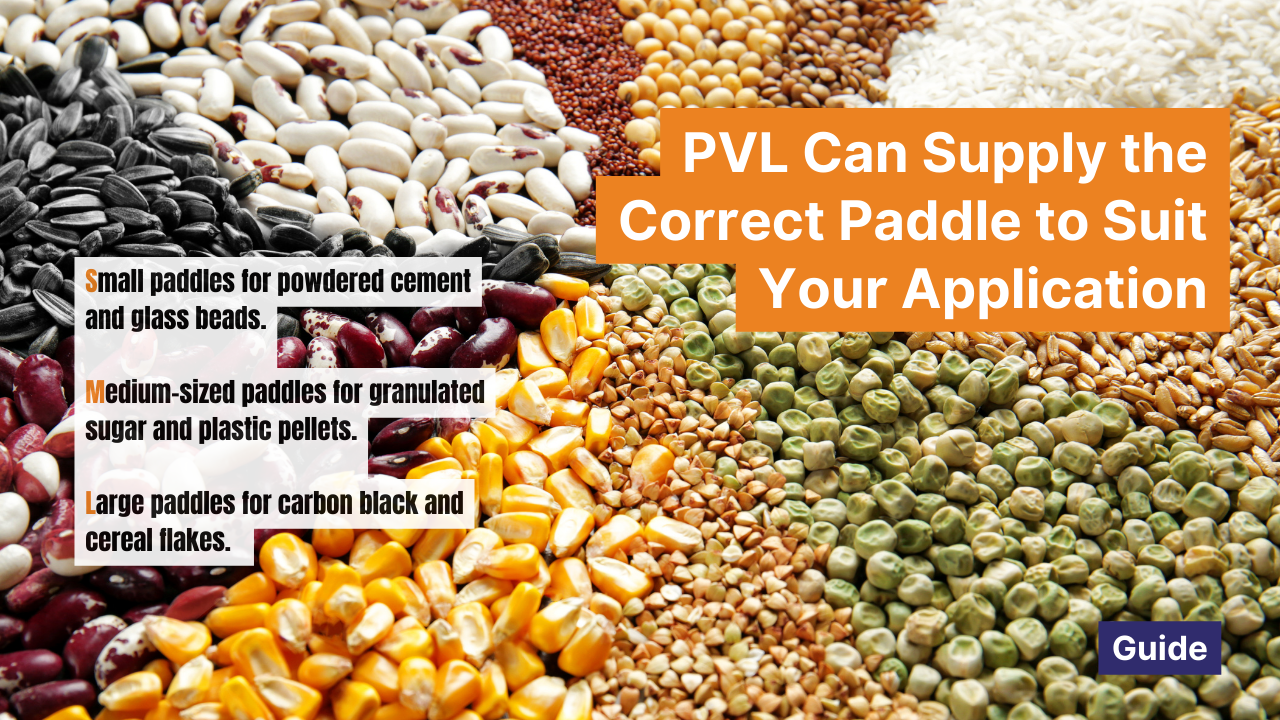
PVL Can Supply the Correct Paddle to Suit Your Application
Understanding Rotary Paddle Level Sensors
Rotary paddle level sensors, also known as rotary paddle level switches or paddlewheel level indicators, are widely used in bulk solids storage due to their simple design, affordability, and versatility. They detect the presence or absence of material at different points in a storage vessel. Their common applications include maintaining specific material levels, preventing overflows, and signalling low material levels for reordering.
The sensor consists of a rotating paddle, or paddle assembly, attached to a drive shaft connected to a gear-and-motor assembly in the power pack. This setup is installed through the vessel wall, with the paddle inside and the power pack outside. When material contacts the paddle, it stops rotating, triggering an output switch indicating its presence. Choosing the correct paddle type is crucial for accurate material level detection, and this choice depends on the material's characteristics and the installation location.
Assessing Your Material's Characteristics
Bulk Density
The bulk density of your material significantly impacts paddle selection. Materials with different bulk densities require paddles with varying surface areas to provide the necessary resistance to stop paddle rotation and trigger the sensor.
- High Bulk Density (>65 lb/ft³ or >1041 kg/m³): Materials like powdered cement and glass beads need smaller paddles with minimal surface area.
- Average Bulk Density (25-65 lb/ft³ or 400-1041 kg/m³): Materials like granulated sugar and plastic pellets require medium-sized paddles.
- Low Bulk Density (5-24 lb/ft³ or 80-384 kg/m³): Materials like carbon black and cereal flakes need larger paddles with greater surface area.
Materials with a bulk density less than 5 lb/ft³ are too light for rotary paddle level sensors, and other types of sensors, such as vibratory level sensors, are more suitable.
Flow Properties
It is also important to understand whether your material is very free-flowing, generally free-flowing, or sluggish. Free-flowing materials like coffee beans or dried grains require different paddle considerations than sluggish materials like charcoal or wood chips. This information helps determine the paddle's resistance and influences the sensor's mounting location.
Determining the Mounting Location and Method
Mounting Location
The mounting location on the vessel side or top depends on the paddle type and the desired monitoring point (low, intermediate, or high). Horizontal mounting on the vessel side is typical, while vertical mounting is used for top-mounted sensors. Proper location ensures that the material covers the paddle during filling and clears during discharge without being in the direct flow of incoming or outgoing material, protecting it from damage.
Mounting Method
The method varies depending on the paddle size and shape. Larger paddles often require mounting from outside the vessel through a hole, while smaller, insertable paddles can be inserted through a welded half coupling. Accessories like flexible couplings, shaft extensions, and shaft guards can help ensure optimal installation and protection.
Exploring Common Paddle Types
Three-Vane Paddles
Three-vane paddles are versatile and suitable for indicating low, intermediate, and high material levels. They come in standard and larger sizes:
- Standard Three-Vane Paddle: With a turning circle of 5-7 inches and vane height of 1.5-2 inches, it works well with average- and high-bulk-density materials.
- Larger Three-Vane Paddle: With a turning circle of 7-9 inches and vane height of 2-2.5 inches, it's better suited for low-bulk-density materials.
Two- and Four-Vane Paddles
Two—and four-vane paddles are ideal for high-bulk-density materials like those used in cement-mix batching plants. They typically have a turning circle of 5-8 inches and vane height of 1-2.5 inches. Due to their size, these paddles usually require mounting with an adaptor plate.
Single-Vane (Insertable) Paddles
Single-vane paddles, including single-vane and single-vane scimitar paddles, are insertable and provide low and high level detection:
- Single-Vane Paddle: With a turning circle of 4.5-8 inches and vane height of 1-2.5 inches, it's suitable for high-bulk-density materials with smaller particle sizes.
- Single-Vane Scimitar Paddle: With a turning circle of 5-7 inches and vane length of 6-8 inches, it detects low and high levels of low- and average-bulk-density materials.
Specialty Paddles
Triangular Single-Vane Paddle
This paddle, with a turning circle of about 9 inches and a length of 5.75 inches, is ideal for fibrous materials like shredded newspaper or wood bark. Its triangular shape minimises tangling, making it effective for such challenging applications. It requires mounting with an adaptor plate and should be used with a vertically mounted sensor.
Belt Paddle
The belt paddle detects high levels in high-bulk-density materials with large particles. Made of durable, flexible materials like canvas and styrene-butadiene rubber, it can absorb the force of heavy materials without damage. It requires adaptor-plate mounting and is suitable for vertically mounted sensors.
Making Your Choice
Choosing the right paddle for your rotary paddle level sensor is essential for accurate and reliable material level detection. Factors such as material bulk density, flow properties, mounting location, and method play critical roles in this decision. Working closely with our experts here at PVL can help you select the best paddle type to meet your specific needs, ensuring efficient operation in your bulk solids processing or handling application.
Conclusion
The effectiveness of a rotary paddle level sensor largely depends on selecting the appropriate paddle type. By thoroughly understanding your material's characteristics and the installation requirements, you can make an informed decision that enhances the performance and reliability of your level sensing system. Whether dealing with high-density materials in a cement plant or low-density powders in a food processing facility, the right paddle ensures accurate level detection, preventing overflows and material shortages.

